The rapid growth of eCommerce both led to and was caused by increasing competition, as more and more business formation flocked to the online shopping industry due to the convenience it offers.
To stay successful and competitive in this ever-changing industry, you must be familiar with the latest eCommerce trends that are redefining the retail industry. Another alternative you might want to consider is hiring an eCommerce marketing agency to help you stay afloat in an increasingly saturated market.
In this article, we’ve compiled ten online shopping trends that will dominate eCommerce in 2024.
Table of Contents
- eCommerce Trend #1: Voice Commerce
- eCommerce Trend #2: Visual Commerce
- eCommerce Trend #3: Mobile Commerce
- eCommerce Trend #4: Augmented Reality
- eCommerce Trend #5: Subscription Model
- eCommerce Trend #6: Email Marketing With Greater Personalization And Interactivity
- eCommerce Trend #7: Conversational UX
- eCommerce Trend #8: Omnichannel Retail
- eCommerce Trend #9: Personalization and AI (Artificial Intelligence)
- eCommerce Trend #10: Sustainability and Ethical Shopping
- 2024 eCommerce Trends Takeaways
- eCommerce Trends FAQs
eCommerce Trend #1: Voice Commerce
Voice assistants and voice-enable devices aren’t exactly a novelty anymore.
Devices such as Amazon Echo and Google Home are becoming increasingly popular as well as increasingly capable thanks to advancements in AI and machine learning.
Of course, it was only a matter of time until their capabilities found an application in eCommerce.
That’s how voice commerce was born—a niche of online shopping where customers use their voice-controlled devices to make purchases.
However, voice commerce will not stay a niche for long—it’s set to become one of the major eCommerce trends.
There are plenty of numbers to support this forecast–let’s look at some key estimates by OC&C:
- Voice commerce will account for $40 billion of all US eCommerce revenue by 2023
- By 2023, an estimated 55% of U.S. households will own a smart speaker
- As many as 36% of U.S. smart speaker owners already purchase items entirely through their smart speakers on a regular basis
The question is not whether voice commerce will become a driving force in eCommerce, but whether your eCommerce website is optimized to accommodate it.
In order to be competitive in voice commerce, follow these voice SEO best practices:
- Optimize your content for answering questions: Most voice queries tend to be long and conversational. For your website to appear in the voice search results, it should answer the voice query clearly and concisely. As such, you should optimize your website content for long-tail keywords and full sentences.
- Set up voice assistant skills for your website: For your website to support voice purchases, it has to be set up with the so-called voice assistant skills. This is something that will require some degree of developer input and can be achieved using the proprietary software from Amazon or Google that works with their respective voice assistants or by using third-party plugins.
- Make the conversion path on your website as short and straightforward as possible: When someone uses their smart speaker to make a purchase, it is the voice assistant who has to go down a website’s conversion path. To make sure that their conversion journey is successful, optimize the purchasing process on your website to be as straightforward as possible and comprehensible to the assistant's AI.

eCommerce Trend #2: Visual Commerce
Ever since eCommerce first emerged as a concept, it has had one specific drawback compared to traditional retail—the customers’ inability to physically interact with a product before making a purchase.
Enter visual commerce. It is a blanket term for the many different ways in which online sellers can use visual elements to enhance the customer’s shopping experience.
In a way, visual commerce aims to revolutionize the outdated standards of product presentation in online retail—the familiar “picture on the left, description on the right.”
Aside from the place of the pictures on the page, you should also carefully consider using the right fonts that complement your website. If you are using a stylish logo design, you should consider using tattoo fonts.
In visual commerce, visuals don’t just supplement product descriptions. Instead, they take the center stage to create a more immersive, realistic online shopping experience.
Visual commerce is now emerging as one of the hottest online shopping trends. Its growth is driven by three key factors:
- Advancements in image recognition technology: Powered by the constantly improving machine learning and deep learning tech, present a significant opportunity for a market research company. The image recognition market is set to hit $86.32 billion by 2027. And as image recognition gets more capable and sophisticated, so does visual search – a tool that's becoming more and more prevalent in visual commerce.
- The emergence of Augmented Reality: Global retailer AR spending is expected to surpass $4 billion by 2026. Augmented reality is just one of the manifestations of visual commerce that’s becoming increasingly popular. Integrating AR functionality into an eCommerce website can create some of the most immersive shopping experiences for customers.
- Overall dominance of visual content: Think Snapchat, Instagram, TikTok – visual content has been dominating the web recently. Video in particular has become, arguably, the most important content format. It is only natural that the shift toward visual content has affected eCommerce as well by accelerating the growth of visual commerce.
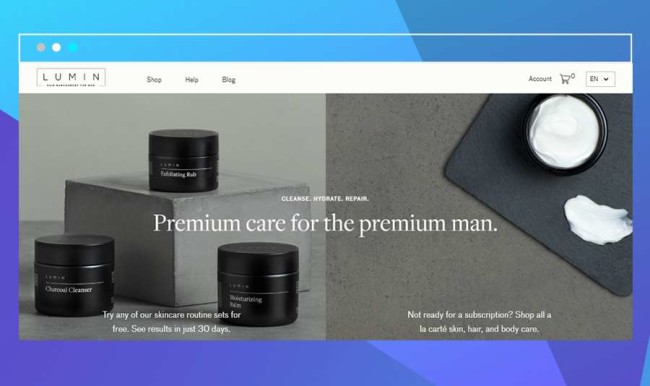
[Source: Lumin]
eCommerce Trend #3: Mobile Commerce
Mobile devices account for around 50% of global web traffic – and a significant portion of this traffic goes to eCommerce.
As such, it is absolutely imperative that eCommerce websites are optimized for mobile devices. One way to achieve this is to search for a reliable eCommerce website design company that can meet all your needs. However, make sure to do your research properly before you make your final choice.
Mobile optimization rests on two basic principles:
- Responsiveness: How functional and usable the website is across devices and platforms
- Speed: How fast the website loads and operates
There are a few steps you can take to ensure that your eCommerce platform delivers an outstanding user experience to mobile visitors:
- Make your website as fast as possible: 40% of users will instantly close a page that takes three or more seconds to load. As you can imagine, it is imperative that you optimize the loading speed of your website. To develop a course of action when optimizing your website for speed, use a tool such as Google’s PageSpeed Insights. It will thoroughly audit your website and give you directions on what might be slowing it down.
- Develop Accelerated Mobile Pages: Accelerated Mobile Pages (AMPs) is an open source software technology developed by Google with a simple goal in mind – to make websites load faster and be more responsive on mobile devices. While the use AMPs in eCommerce is controversial, implementing them across your website could improve its overall response time and the user experience of your visitors.
- Streamline the checkout process: On average, 21% of users will abandon the checkout process on your website if they find it to be too complicated. And if the checkout process on your eCommerce website is, indeed, overly complicated, it will be only more frustrating for mobile visitors. That’s why you should streamline it in a way that will grant both desktop and mobile visitors the best user experience possible.
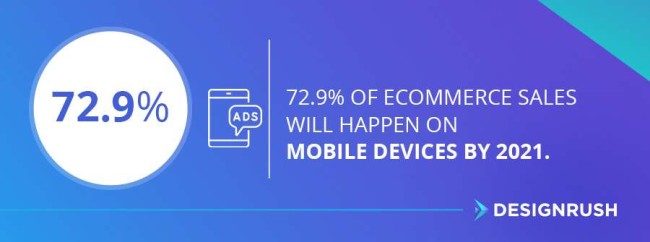
eCommerce Trend #4: Augmented Reality
Today, online retailers are going beyond the standard product pages with still images on the left-hand side and product descriptions on the right-hand side.
Augmented reality tech is set to enrich, if not revolutionize the online shopping experience.
The demand for it is driven by one major issue that many consumers face when shopping online – lack of interactivity.
Unlike traditional retail, online stores don’t offer their customers an opportunity to see and interact with a real-life version of the product before making a purchase.
Augmented reality solves this problem at least to some extent by allowing the customers or, rather, the customers’ devices, to “materialize” the product and interact with it.
And while AR might still seem like a somewhat futuristic technology, its application in eCommerce is becoming more sought-after.
22% of consumers say that AR tech in eCommerce would drive them to visit traditional brick-and-mortar stores less often.
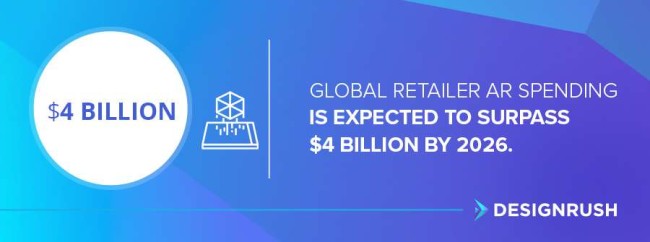
eCommerce Trend #5: Subscription Model
In the current eCommerce landscape, subscriptions are no longer limited to streaming services or cloud storage.
In fact, there are plenty of online retailers that are entirely based around the subscription model.
The logic behind this model in eCommerce is simple – the customer pays a regular fee (usually, a monthly one) and receives a pre-made package of goods or services in return.
The best and perhaps most famous example is Dollar Shave Club, which started by offering shaving supplies at a low cost and ended up popularizing the eCommerce subscription model.
That model has come a long way since Dollar Shave Club was founded in 2011. SUBTA estimates that by2023, 75% of direct-to-consumer companies will implement the subscription model.
Moreover, a report by Royal Mail shows that in the UK alone the subscription box market will reach $1 billion by 2023.
The subscription model is one of the fastest-growing eCommerce trends and for a solid, yet simple reason: convenience.
Subscriptions are hassle-free, for retailers as well as customers.
The retailers, on one hand, don’t have to worry so much about inventory and logistics costs, as they can easily predict just how many bundles of products they will need to ship.
The customers, on the other hand, benefit from this model in a similar way. Once they sign up for a subscription, they can expect to receive the same (or a purposefully different) bundle of goods for a flat fee between equal time periods.
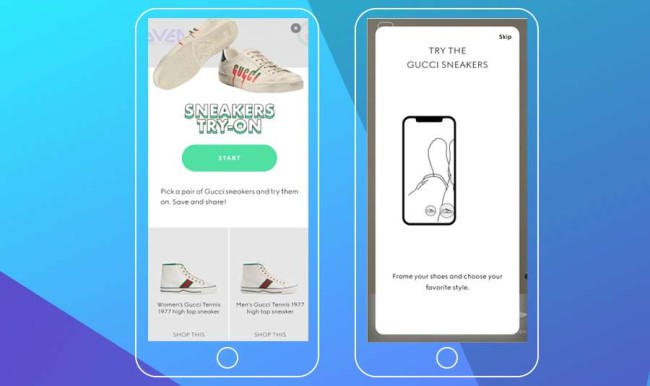
[Source: Gucci]
eCommerce Trend #6: Email Marketing With Greater Personalization And Interactivity
Email marketing has been making a comeback recently – and for a few good reasons.
Not only is it universal (you can reach almost anyone via email), it also offers a lucrative ROI of 42:1, when done right.
However, email marketing in eCommerce is far from your typical dry newsletters. Today, it’s taking a turn to personalization and interactivity. A catchy subject line and an attention-grabbing email signature are key components of a personalized email marketing strategy.
70% of millennial customers would prefer to receive personalized emails from retailers.
The personalization eCommerce trend also goes beyond email marketing, as over 50% of online shoppers look for personalized experiences.
Tailoring your content to a specific customer or group of customers takes time and effort.. However, it’s a solid way of connecting with and retaining your target audience.
Interactive emails serve the same purpose. And while they are growing in popularity, they are not yet universally adopted.
In 2019, as many as 45% of marketers had no prior experience with interactive emails.
This presents a lucrative opportunity for businesses who are willing to go an extra mile with their email marketing efforts and stand out from the competition.
eCommerce Trend #7: Conversational UX
Conversational User Experience is a set of techniques that make the online experiences of your customer appear more casual, intimate and personal.
While its’s a broad term that includes many practices, the most prevalent manifestation of Conversational UX, by far, are chatbots.
Ecommerce chatbot can be implemented via dedicated plugins for your website, or via an existing app such as the Facebook Messenger.
Depending on how they are programmed, chatbots can emulate a natural human conversation and help a customer make a purchase or resolve a complaint.
The rising demand for chatbots across eCommerce businesses has to do with the rising popularity of messengers among consumers.
According to HubSpot, 47% of consumers feel comfortable making purchases through a bot in a messenger app and 71% are open to receiving customer support via a messenger app.
Chatbots are fast, convenient and fit into the online culture of instant gratification. Not to mention, they’re a great way to engage your website visitors and streamline their conversion journey.
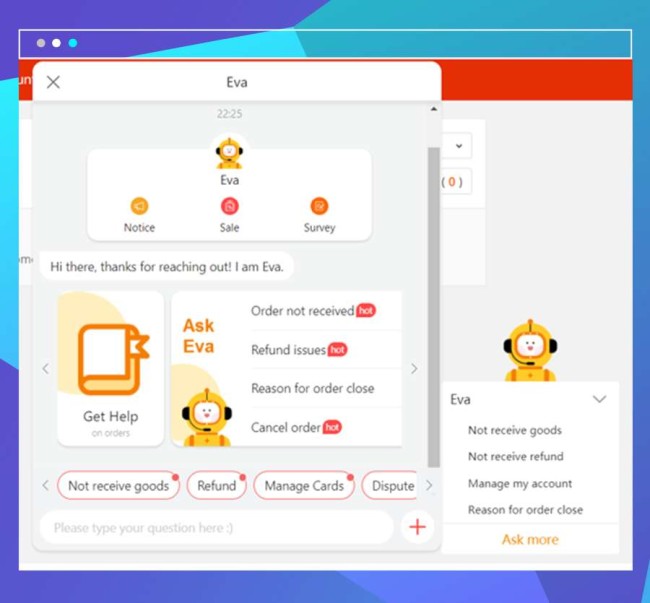
[Source: AliExpress]
eCommerce Trend #8: Omnichannel Retail
More and more eCommerce businesses understand the importance of providing a seamless shopping experience across multiple channels, such as websites, mobile apps, social media platforms, and physical stores.
The goal of omnichannel retail is to create a consistent and cohesive customer journey no matter where the device the customer is shopping from or the store they chose to visit.
Omnichannel retail allows customers to start their shopping journey on one channel and complete it on another. For example, a customer might research a product on a mobile app and then purchase in a physical store.
To do this, brands must ensure the branding, messaging, and overall customer experience remains consistent across all channels. This consistency helps build trust and recognition among customers.
Businesses that employ omnichannel strategies gather and centralize customer data from various touchpoints. This data helps create a more holistic view of each customer, enabling personalized marketing and improved customer service.
Thanks to this data, brands can customize their marketing efforts and recommendations to individual customers. This type of personalization is known to boost customer engagement and conversion rates.
One of the most popular omnichannel strategies is non-other than the Buy Online, Pick Up In-Store (BOPIS) approach. As the name suggests, customers get to shop online and choose to pick up their purchases at a nearby store, blurring the lines between online and offline shopping.
eCommerce Trend #9: Personalization and AI (Artificial Intelligence)
If you choose to use personalization and AI together, you can significantly improve the custom experience your eCommerce business provides.
As mentioned above, personalization in eCommerce refers to tailoring the shopping experience to individual customers' preferences, behaviors, and needs. It involves delivering content, product recommendations, and marketing messages that are relevant and specific to each customer.
Personalization is a game-changer when it comes to customer engagement and loyalty, as well as conversion rates. Let’s not even mention that cross-selling and upselling personalized recommendations can lead to higher-order values and reduced cart abandonment.
If you couple personalization and AI, you’re almost invincible.
AI plays a critical role in implementing effective personalization strategies. Machine learning algorithms analyze vast amounts of data to understand customer behaviors, preferences, and patterns. These insights are then used to deliver personalized experiences across different touchpoints.
AI-powered recommendation systems analyze customer browsing and purchase history to suggest products like those they've shown interest in or purchased before. Plus, AI has the capacity to predict customer behaviors, making it that much easier for you to guide the customer through the sales funnel.
It’s obvious that as AI technology advances, personalization will become even more refined. Not so long in the future, businesses will be able to predict customer preferences with greater accuracy, leading to hyper-personalized experiences.
eCommerce Trend #10: Sustainability and Ethical Shopping
Caring about the planet will never go out of style. Sustainability has transitioned from being a niche concern to a mainstream priority. eCommerce businesses are recognizing that integrating sustainable practices can attract environmentally conscious consumers and drive brand loyalty.
As an eCommerce business, you should consider investing in innovative packaging solutions that minimize waste and environmental impact. This includes using recyclable, biodegradable, and compostable materials, as well as exploring packaging-free options.
Another important consideration is to measure and reduce your carbon footprint. Commit to becoming carbon-neutral by offsetting emissions through various initiatives such as tree planting, renewable energy projects, and carbon credits.
Having in mind that consumers are demanding greater transparency about supply chains to ensure that products are ethically sourced and produced, provide all the information about sourcing, production practices, and labor conditions they need. Display sustainability certifications and labels prominently, such as Fair Trade, Organic, and B Corp to offer your customers quick reassurance of a product's ethical and environmental credentials.
Go as far as leveraging content marketing to educate consumers about the importance of sustainable and ethical choices. This educational content not only helps customers make informed decisions but also fosters a sense of shared values with your brand.
2024 eCommerce Trends Takeaways
Over the past decade, eCommerce transformed from just another way to shop to a massive global industry.
Up until a few years ago, it was fascinating to find a brand that had an eCommerce presence. Now it is more fascinating to find one that doesn’t.
But rapid growth is only one of the major eCommerce trends to consider. After all, it’s an ever-evolving industry that only gets more sophisticated and competitive.
The key online shopping trends to watch out for in 2024 are:
- Voice commerce
- Visual commerce
- Mobile commerce
- Augmented reality
- Subscription model
- Email marketing
- Conversational UX
Following these trends is one of the essential steps you’ll need to take to ensure that your eCommerce website outperforms the competition in 2024 and drives outstanding results. eCommerce as well as an enterprise software development company is your good ally when it comes to help you achieving those goals.
eCommerce Trends FAQs
1. What will be the future of eCommerce?
The future of eCommerce holds trends such as increased personalization, seamless omnichannel experiences, AI-driven advancements, and sustainable practices. Mobile commerce, voice shopping, and virtual reality are expected to rise. Ethical and transparent business practices will become crucial, and technologies like blockchain might enhance security and supply chain transparency.
2. Will eCommerce grow in 2023?
eCommerce will continue to experience growth in 2023. The ongoing shift towards online shopping, advancements in technology, and changing consumer behaviors indicate a sustained upward trajectory for this industry. However, specific growth rates can vary based on factors such as market trends, economic conditions, and global events.
3. Which country is no 1 in eCommerce?
China has the largest eCommerce industry. Countries like the United States, South Korea, and the United Kingdom also have strong eCommerce markets.









